Related Research Articles

Changshan, also known as changpao, and dagua, is a form of paofu, Chinese robe, which was derived from the Qing dynasty qizhuang, the traditional dress of the Manchu people, which were worn by Manchu men. The changshan was actually developed by the Han Chinese through the modification of their own Ming dynasty's Hanfu by adopting some Manchu men's clothing elements in one of their Hanfuchangshan. In function, the changshan is considered the male equivalent of the women's cheongsam. The changshan was often worn by men with a magua, also commonly translated as "riding jacket" in English language.

A mandarin square, also known as a rank badge, was a large embroidered badge sewn onto the surcoat of officials in Imperial China, Korea, in Vietnam, and the Ryukyu Kingdom. It was embroidered with detailed, colourful animal or bird insignia indicating the rank of the official wearing it. Despite its name, the mandarin square falls into two categories: round buzi and square buzi. Clothing decorated with buzi is known as bufu in China. In the 21st century, the use of buzi on hanfu was revived following the Hanfu movement.
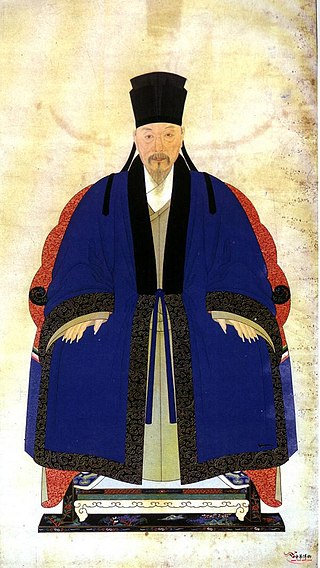
Beizi, also known as beizi and chuozi, is an item worn in traditional Chinese attire common to both men and women; it is typically a large loose outer coat with loose and long sleeves. It was most popular during the Song dynasty, Ming dynasty, and from the early Qing to the Mid-Qing dynasty. The beizi originated in the Song dynasty. In the Ming dynasty, the beizi was referred as pifeng. When worn by men, it is sometimes referred as changyi, hechang, or dachang when it features large sleeves and knotted ties at the front as a garment closure.

Gwanbok is a Sino-Korean term derived from the terms guanfu and guanfu. The term gwanbok is a collective term which refers to historical official attire, which was bestowed by the government court, including Chinese courts of various dynasties. The guanfu (冠服) system was a court attire system in China which also formed part of the Hanfu system. This system was them spread to neighbouring countries and was adopted in Korea since ancient times in different periods through the ritual practice of bestowal of clothing. Acknowledgement through bestowed robes and crowns (冠服) from the Emperor of China, who held hegemony over East Asia, would give support to Korean Kings and successors, as being the authentic rulers of their country as well as confirmed the political status of the Korean kingdom in the rest of the Sinosphere. The gwanbok system in Korea was different for each kingdom and changed throughout different periods. For example, initially given by the Chinese court in ritual practice, successive gwanbok were more often than not locally manufactured in Korea with different colours and adopted into hanbok. The gwanbok, which was used as the uniform of court officials, formed part of the gwanbok system and was used like the suit is nowadays.
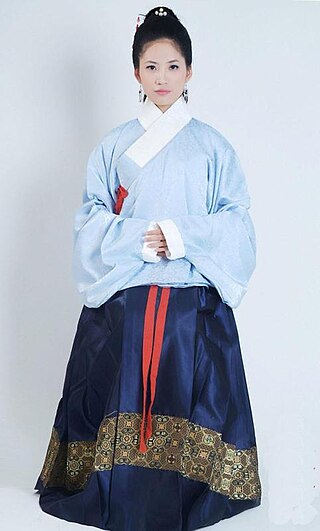
Ruqun is a set of attire in Hanfu which consists of a short jacket typically called ru worn under a long Chinese skirt called qun. However, when use as a general term, ruqun can broadly describe a set of attire which consists of a separated upper garment and a wrap-around lower skirt, or yichang, in which yi means the "upper garment" and the chang means the "lower garment". In a broad sense, ruqun can include the shanqun and aoqun in its definition.
A yuanlingshan is a type of round-collared upper garment in the traditional Chinese style of clothing known as Hanfu; it is also referred to as a yuanlingpao or a panlingpao when used as a robe. The yuanlingshan and yuanlingpao were both developed under the influence of ancient Chinese clothing, known as Hufu, originating from the Donghu people during the early Han dynasty and later by the Wuhu, including the Xianbei people, during the Six Dynasties period. The yuanlingpao is an article of formal attire primarily worn by men, although in certain dynasties, such as the Tang dynasty, it was also fashionable for women to wear. In the Tang dynasty, the yuanlingpao could be transformed into the fanlingpao using buttons.
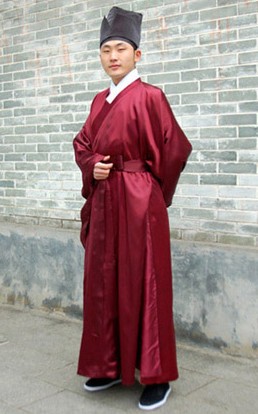
Daopao, also known as xuezi when used as a Xifu during Chinese opera performances, and deluo when it is blue in colour, is a traditional form of paofu in Hanfu and is also one of the most distinctive form of traditional clothing for the Han Chinese. The daopao was one of the most common traditional form of outer robe worn by men. Daopao literally means "Taoist robe"; however, despite its name, the daopao were and is worn by men, and did not imply that its wearer had some affiliation to taoism. The daopao can be dated back to at least the Ming dynasty but had actually been worn since the Song dynasty. Initially the daopao was a form of casual clothing which was worn by the middle or lower class in the Ming dynasty. In the middle and late Ming, it was one of the most common form of robes worn by men as casual clothing. The daopao was also a popular formal wear by the Ming dynasty scholars in their daily lives. It was also the daily clothing for the literati scholars in the Ming dynasty. In the late Ming, it was also a popular form of clothing among the external officials and eunuchs sometimes wore it. The daopao was also introduced in Korea during the Joseon period, where it became known as dopo and was eventually localized in its current form.

Fengguan, also known as phoenix coronet or phoenix hat, is a type of guan for women in Hanfu. It was worn mainly by noblewomen for ceremonies or official occasions. It is also traditional headgear for brides and could be worn in set of Traditional Chinese wedding dress attire, such as the fengguan xiapei.

Diyi, also called known as huiyi and miaofu, is the historical Chinese attire worn by the empresses of the Song dynasty and by the empresses and crown princesses in the Ming Dynasty. The diyi also had different names based on its colour, such as yudi, quedi, and weidi. It is a formal wear meant only for ceremonial purposes. It is a form of shenyi, and is embroidered with long-tail pheasants and circular flowers. It is worn with guan known as fengguan which is typically characterized by the absence of dangling string of pearls by the sides. It was first recorded as Huiyi in the Zhou dynasty.

Daxiushan, also referred as dianchailiyi, dashan, daxiu, is a form of shan, a traditional Chinese upper garment, with broad sleeves in Hanfu. It was most popular during the Tang dynasty, particularly among the members of royalty. The daxiushan was mainly worn for special ceremonial occasions and had different variations, mainly the result of different collar formations. The daxiushan could be worn under a skirt or as an outerwear. After the Tang dynasty, it continued to be worn in the Song and Ming dynasties.

In China, women had different kinds of clothes in ancient times. Those clothes changed with the dynasty. For examples, in the 1920s, the Cheongsam was fashionable among socialites and upperclass women; during the 1960s, very austere clothing styles were prevalent; today, a wide variety of fashions are worn. Different provinces and regions of China also have different clothing styles.

Hanfu are the traditional styles of clothing worn by the Han Chinese since the 2nd millennium BCE. There are several representative styles of hanfu, such as the ruqun, the aoqun, the beizi and the shenyi, and the shanku.

Yunjian, also known as Cloud collar in English and sometimes referred as châr-qâb, is a Chinese term which can either to a four-lobed motif, or to a traditional Chinese garment accessory item in Hanfu, the Traditional clothing of the Han Chinese, which is typically found in the form of a detachable collar with cloud patterns and is worn over the shoulders area, similar to a shawl. As an garment accessory, the yunjian is also typically found in four-lobed design although multi-lobed design also existed throughout history. The yunjian could also be applied directly on garments, where it would fall around the collar of robes onto the chest and shoulder region,or as a clothing appliqué. In China, the yunjian has both ceremonial and practical uses when used in clothing. As a garment item, the yunjian was an important clothing element for Chinese women, especially in the Ming and Qing dynasties; its usage was spread across China where it became associated with the Han Chinese's wedding clothing. In Henan, brides would wear yunjian decorated with hanging ribbons and bells. It also had the practical use of preventing clothing from being dirty and oily by covering up the clothes and by covering up the stains. The yunjian is used in Peranakan wedding; the multi-layered yunjian worn by Chinese brides on the day of their wedding is sometimes known as "phoenix collar". The yunjian also started to be worn by the Non-Chinese, the Tartars of northern China and Manchuria in the later medieval period.

Qungua, also known as longfenggua, or longfeng qungua, or guaqun, is one type of two-piece ceremonial traditional Chinese wedding set of attire, which is composed of a jacket called gua (褂) and of a long Chinese skirt called qun (裙). The qungua is a type of Hanfu worn by Han Chinese brides and originated in the 18th century during the Qing dynasty. It eventually became the traditional wedding attire of Cantonese brides in the Guangdong regions. It is traditionally handmade and is decorated with dragons and phoenixes embroideries. Nowadays, the qungua is still popular as a wedding dress in China, including in Hong Kong and Macau.
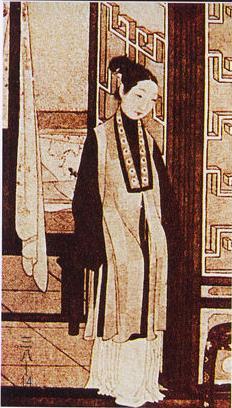
Bijia is a long, sleeveless jacket of Mongol origins which has opened side slits. The bijia started to be worn in the Yuan dynasty when it was designed by Empress Chabi. The bijia eventually became one of the most typical form of women's clothing item in the Ming dynasty and in the Qing dynasty. It is also a type of hanfu which has been revived in present days.

Qizhuang, also known as Manfu and commonly referred as Manchu clothing in English, is the traditional clothing of the Manchu people. Qizhuang in the broad sense refers to the clothing system of the Manchu people, which includes their whole system of attire used for different occasions with varying degrees of formality. The term qizhuang can also be used to refer to a type of informal dress worn by Manchu women known as chenyi, which is a one-piece long robe with no slits on either sides. In the Manchu tradition, the outerwear of both men and women includes a full-length robe with a jacket or a vest while short coats and trousers are worn as inner garments.

Tanling ruqun, also known as Tan collar ruqun and U-collar ruqun, is a type of Hanfu which was developed under the influence of Hufu ; it is a form a kind of ruqun which typically consists of three parts, featuring a low-cut low-cut U-shaped collar upper inner garment with long sleeves, a U-shaped collar banbi upper outer garment with short sleeves, a long high-waisted skirt. It can also be adorned with a shawl, called pipo. It was a popular form of clothing attire in the Sui and Tang dynasty. In the 21st century, the Tanling ruqun re-appeared as a result of the Hanfu movement. The 21st century Tanling ruqun was developed by reproducing the original patterns of the historical tanling ruqun while being aligned with modern aesthetics.
Chinese auspicious ornaments in textile and clothing refers to any form of Chinese auspicious ornaments, which are used to decorate various forms of Chinese textile and clothing, fashion accessories, and footwear in China since the ancient times. Chinese auspicious ornaments form part of Chinese culture and hold symbolic meanings. In ancient China, auspicious ornaments were often either embroidered or woven into textile and clothing. They are also used on religious and ritual clothing and in Xifu, Chinese opera costumes. Auspicious symbols and motifs continue to be used in present-day China in industries, such as home textiles and clothing; they are also used in modern design packaging and interior design. Some of these Chinese auspicious ornaments were also adopted by European countries during the era of Chinoiserie, where they became decorative patterns on fashionable chinoiserie fashion and textiles.

Traditional Chinese wedding dress is a collective term which refers to all the different forms and styles of traditional wedding attire worn by the Han Chinese when performing their marriage ceremony, including the traditional Chinese marriage. There are various forms of traditional Chinese wedding dress in the history of China. Since the Zhou dynasty, there have national laws and rules which regulated the different categories of clothing and personal accessories; these regulations have created various categories of clothing attire, including the traditional wedding attire of the Chinese people.

Fengguan xiapei is a type of traditional Chinese wedding set of attire categorized under Hanfu, which was worn by Han Chinese women in Ming and Qing dynasties. The fengguan xiapei attire was composed an upper and lower garment following the traditional Chinese yichang clothing system. It was typically composed of a red coloured mang ao, a type of a Chinese qun-skirt known as mangchu, the xiapei, and the fengguan. The fengguan xiapei was sometimes adorned with the yunjian. Following the wedding ceremony, married women were expected to wear the fengguan xiapei on formal occasions, however, Chinese trousers or leggings were worn beneath instead of the skirt.
References
- 1 2 3 4 5 6 "Hapi(霞帔)". Encyclopedia of Korean Folk Culture.
- 1 2 3 4 5 6 7 8 9 10 11 12 13 14 15 16 17 Yang, Shaorong (2004). Traditional Chinese clothing : costumes, adornments & culture (1st ed.). San Francisco: Long River Press. pp. 32–33. ISBN 1-59265-019-8. OCLC 52775158.
- 1 2 3 4 Lewandowski, Elizabeth J. (2011). The complete costume dictionary. Lanham, Maryland: The Scarecrow Press. p. 319. ISBN 978-0-8108-4004-1. OCLC 694238143.
- 1 2 3 4 KESSLER, ADAM T. (2017-08-23). "The Last Days of the Song Dynasty: Evidence of the Flight of Song Officials to Southeast Asia before the Mongol Invasions". Journal of the Royal Asiatic Society. 28 (2): 315–337. doi:10.1017/s1356186317000384. ISSN 1356-1863. S2CID 164576372.
- ↑ "History of Peizhui - Most Exquisite Hanfu Ornament". www.newhanfu.com. 28 December 2020. Retrieved 2022-01-02.
- ↑ "Jeogui: The Most Formal Ceremonial Robe of the Joseon Queens". National Museum of Korea.
- 1 2 3 4 5 Xun Zhou; Chunming Gao (1987). 5000 years of Chinese costumes. San Francisco, CA: China Books & Periodicals. pp. 150, 195. ISBN 0-8351-1822-3. OCLC 19814728.
- 1 2 "【金银器】帔坠_收藏文化_银元收藏网". www.mugwum.com. Retrieved 2022-01-02.
- 1 2 3 Tibberts, Jennifer (2021-01-01). "Investigating How Qipao and Hanfu Dresses are Representative of China". Senior Honors Theses: 1–52.
- ↑ Vollmer, John E. (2007). Dressed to rule : 18th century court attire in the Mactaggart Art Collection. Mactaggart Art Collection. Edmonton: University of Alberta Press. p. 46. ISBN 978-1-55195-214-7. OCLC 166687933.
- ↑ "Jeokgwan". Encyclopedia of Korean Folk Culture.
| Xiapei | |
|---|---|
 Portrait of Empress Dowager Du wearing scarf-like xiapei over her shoulders; a peizhui (ornament) is hanging at the front end, Song dynasty. | |
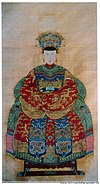 Portrait of Mrs Chen wearing the waistcoat-like xiapei, Qing dynasty |
| Characteristics |
| ||||||||||||||||||
|---|---|---|---|---|---|---|---|---|---|---|---|---|---|---|---|---|---|---|---|
| Garments |
| ||||||||||||||||||
| Headwear (list) | |||||||||||||||||||
| Footwear (list) | |||||||||||||||||||
| Accessories (list) |
| ||||||||||||||||||
| Influenced clothing | |||||||||||||||||||
| Cosmetics | |||||||||||||||||||